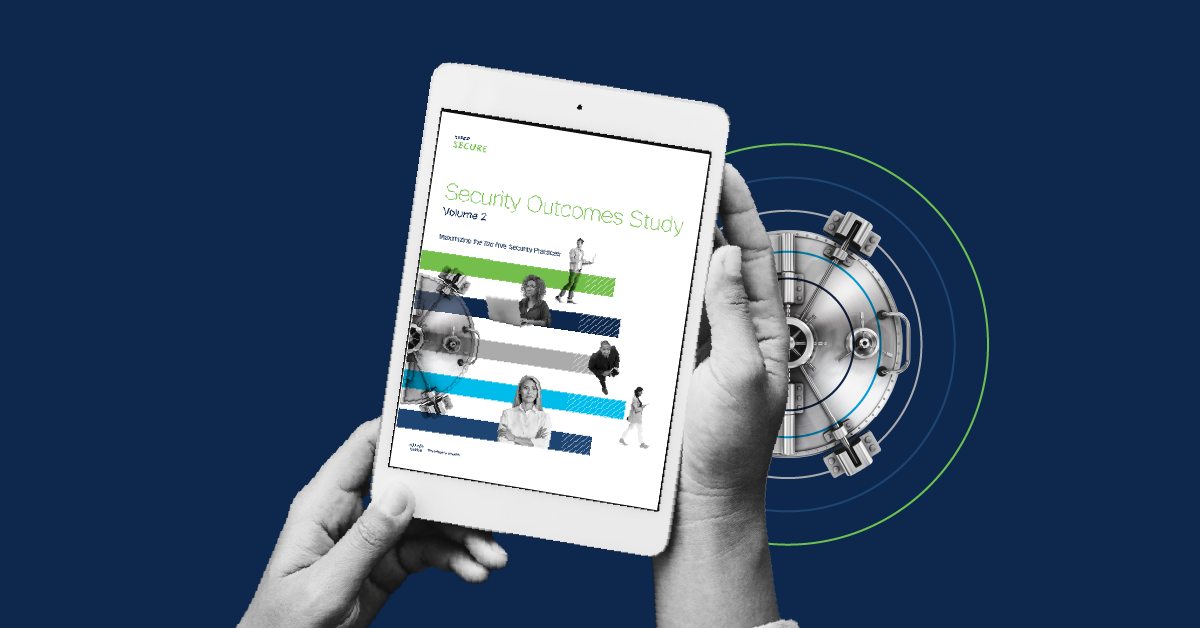- บุคลากรฝ่ายรักษาความปลอดภัยชี้ เทคโนโลยีที่ใช้อยู่ขาดความน่าเชื่อถือและมีความซับซ้อน
- บริษัทต่างๆ เตรียมลงทุนในสถาปัตยกรรมใหม่ด้านการรักษาความปลอดภัย เช่น Zero Trust และ SASE
ซิสโก้เผยแพร่รายงานผลการศึกษาเกี่ยวกับผลลัพธ์ด้านการรักษาความปลอดภัย ฉบับที่ 2 (Security Outcomes Study Volume 2) ซึ่งระบุว่า บริษัทต่างๆ ในไทยจำเป็นอย่างยิ่งที่จะต้องเปลี่ยนไปใช้เทคโนโลยีและโซลูชั่นรุ่นใหม่ใน “โครงสร้างพื้นฐานของไซเบอร์ซีเคียวริตี้” โดยผลการศึกษาเผยว่า 52 เปอร์เซ็นต์ของเทคโนโลยีไซเบอร์ซีเคียวริตี้ที่ใช้งานอยู่ในบริษัทต่างๆ ของไทยจัดว่าล้าสมัย ตามความเห็นของบุคลากรฝ่ายรักษาความปลอดภัย ที่ทำงานอยู่ในองค์กรเหล่านั้น
รายงานดังกล่าวอ้างอิงผลการสำรวจความคิดเห็นของบุคลากรฝ่ายรักษาความปลอดภัยและความเป็นส่วนตัวกว่า 5,100 คนใน 27 ประเทศทั่วโลก รวมถึงบุคลากรกว่า 2,000 คนใน 13 ประเทศในภูมิภาคเอเชีย-แปซิฟิก ผลการศึกษานี้มุ่งที่จะค้นหาแนวทางและมาตรการที่มีประสิทธิภาพมากที่สุดสำหรับการปกป้ององค์กรให้ปลอดภัยจากสถานการณ์ภัยคุกคามที่เปลี่ยนแปลงอย่างต่อเนื่อง ผู้ตอบแบบสอบถาม รวมถึงบุคลากรจากบริษัทต่างๆ ในประเทศไทย ได้เปิดเผยข้อมูลเกี่ยวกับแนวทางของตนเองสำหรับการอัพเดต และบูรณาการสถาปัตยกรรมด้านการรักษาความปลอดภัย การตรวจจับ การตอบสนองต่อภัยคุกคาม และการกู้คืนระบบในกรณีที่เกิดปัญหา
นอกจากนี้ ผู้ตอบแบบสอบถามในประเทศไทยระบุว่าโครงสร้างพื้นฐานด้านไซเบอร์ซีเคียวริตี้ที่ใช้อยู่ในปัจจุบันขาดความน่าเชื่อถือ (43 เปอร์เซ็นต์) และมีความซับซ้อน (28 เปอร์เซ็นต์)
แต่ข่าวดีก็คือ บริษัทต่างๆ ในไทยมีแผนที่จะแก้ไขปัญหาดังกล่าวด้วยการลงทุนในเทคโนโลยีไซเบอร์ซีเคียวริตี้ที่ทันสมัย รวมไปถึงแนวทางใหม่ๆ ซึ่งจะช่วยเสริมสร้างความแข็งแกร่งให้กับระบบรักษาความปลอดภัยขององค์กร ทั้งนี้ ผู้ตอบแบบสอบถามในไทยกว่า 9 ใน 10 คน (93 เปอร์เซ็นต์) เปิดเผยว่า บริษัทของตนมีแผนที่จะลงทุนในแนวทาง ‘Zero Trust’ โดย 57 เปอร์เซ็นต์ระบุว่า องค์กรของตนมีความคืบหน้าอย่างต่อเนื่องในการปรับใช้แนวทางดังกล่าว ขณะที่ 36 เปอร์เซ็นต์ระบุว่า องค์กรของตนได้ปรับใช้แนวทางนี้อย่างกว้างขวาง นอกจากนั้น ผู้ตอบแบบสอบถาม 93 เปอร์เซ็นต์เปิดเผยว่า บริษัทของตนมีแผนที่จะลงทุนในสถาปัตยกรรม Secure Access Service Edge (SASE) โดย 55 เปอร์เซ็นต์ระบุว่า มีความคืบหน้าที่ดีในการปรับใช้สถาปัตยกรรมที่ว่านี้ ขณะที่ 38 เปอร์เซ็นต์ระบุว่า มีการใช้งานสถาปัตยกรรมดังกล่าวในระดับที่พัฒนาอย่างเต็มที่แล้ว
เทคโนโลยีทั้งสองส่วนนี้ถือเป็นกุญแจสำคัญในการสร้างระบบรักษาความปลอดภัยที่แข็งแกร่งสำหรับองค์กรธุรกิจในโลกยุคใหม่ที่มุ่งเน้นการใช้ระบบคลาวด์และแอปพลิเคชันเป็นหลัก ทุกวันนี้องค์กรต่างๆ ต้องเผชิญกับปัญหาท้าทายมากมายในการดำเนินงานในสภาพแวดล้อมดังกล่าว เช่น ความยุ่งยากซับซ้อนในการเชื่อมต่อผู้ใช้เข้ากับแอปพลิเคชันและข้อมูลบนแพลตฟอร์มคลาวด์ที่หลากหลาย นโยบายด้านความปลอดภัยที่ไม่สอดคล้องกันบนตำแหน่งที่ตั้งและเครือข่ายที่แตกต่างกัน ความยากลำบากในการตรวจสอบอัตลักษณ์ของผู้ใช้งานและอุปกรณ์ การที่องค์กรไม่สามารถตรวจสอบโครงสร้างพื้นฐานด้านการรักษาความปลอดภัยได้อย่างทั่วถึง เป็นต้น
สถาปัตยกรรม SASE ได้รับการยอมรับอย่างกว้างขวางว่าเป็นวิธีที่มีประสิทธิภาพในการแก้ไขปัญหาท้าทายเหล่านี้ เพราะ SASE ผสานรวมฟังก์ชั่นการทำงานของระบบเครือข่ายและระบบรักษาความปลอดภัยเข้าไว้ในแพลตฟอร์มคลาวด์ เพื่อรองรับการเข้าถึงแอปพลิเคชันอย่างปลอดภัย ไม่ว่าผู้ใช้จะทำงานอยู่ที่ใดก็ตาม ขณะเดียวกัน แนวทาง Zero-Trust เป็นแนวคิดที่เรียบง่ายซึ่งเกี่ยวข้องกับการตรวจสอบอัตลักษณ์ของผู้ใช้งานและอุปกรณ์ทั้งหมดในทุกๆ ครั้งที่มีการเชื่อมต่อเข้ากับเครือข่ายขององค์กร เพื่อลดความเสี่ยงด้านความปลอดภัย
สถาปัตยกรรมด้านการรักษาความปลอดภัยบนระบบคลาวด์มีคุณประโยชน์อย่างมาก โดยจากผลการสำรวจพบว่า องค์กรที่มีการใช้งานสถาปัตยกรรม Zero Trust หรือ SASE ในระดับที่พัฒนาอย่างเต็มที่แล้ว มีแนวโน้มที่มีการดำเนินงานด้านการรักษาความปลอดภัยที่แข็งแกร่งมากกว่า 35% เมื่อเทียบกับองค์กรที่เพิ่งปรับใช้สถาปัตยกรรมดังกล่าวในระดับเริ่มต้น
เคอร์รี่ ซิงเกิลตัน กรรมการผู้จัดการฝ่ายไซเบอร์ซีเคียวริตี้ของซิสโก้ ประจำภูมิภาคเอเชีย-แปซิฟิก ญี่ปุ่น และจีน กล่าวว่า “องค์กรธุรกิจทั่วโลก รวมถึง ‘ประเทศไทย’ ได้เจอกับความเปลี่ยนแปลงครั้งใหญ่ในรูปแบบการดำเนินงาน ที่เป็นผลมาจากการแพร่ระบาด ขณะที่องค์กรเหล่านี้ต้องวุ่นวายกับความเปลี่ยนแปลงในหลายๆ ด้าน เช่น การที่พนักงานจำนวนมากจำเป็นต้องทำงานจากที่บ้าน การติดต่อสื่อสารและการทำธุรกรรมที่ใช้ช่องทางดิจิทัลเป็นหลัก จึงจำเป็นอย่างยิ่งที่องค์กรจะต้องสามารถเชื่อมต่อผู้ใช้เข้ากับแอปพลิเคชันและข้อมูลที่ต้องใช้งานได้อย่างไร้รอยต่อในทุกสภาพแวดล้อม ไม่ว่าผู้ใช้จะอยู่ที่ใดก็ตาม ขณะเดียวกันก็ต้องสามารถควบคุมการเข้าถึงและบังคับใช้มาตรการป้องกันด้านความปลอดภัยที่เหมาะสม โดยครอบคลุมเครือข่าย อุปกรณ์ และสถานที่ตั้งทั้งหมด”
ฮวน ฮวด คู ผู้อำนวยการฝ่ายไซเบอร์ซีเคียวริตี้ของซิสโก้ ประจำภูมิภาคอาเซียน กล่าวเสริมว่า “สภาพแวดล้อมทางธุรกิจในปัจจุบันถูกขับเคลื่อนด้วยระบบดิจิทัล ดังนั้นบริษัทต่างๆ จึงต้องดำเนินการปรับปรุงไซเบอร์ซีเคียวริตี้อย่างจริงจัง รายงานฉบับล่าสุดของซิสโก้ให้ข้อมูลเชิงลึกที่ดีเยี่ยมแก่บุคลากรฝ่ายรักษาความปลอดภัยในเรื่องที่เกี่ยวกับแนวทางและเทคโนโลยีที่เหมาะสมสำหรับการสร้างระบบรักษาความปลอดภัยที่แข็งแกร่ง ในขณะที่ยังคงให้ประสบการณ์ผู้ใช้ที่ราบรื่น ซึ่งจะช่วยให้บุคลากรเหล่านี้มีทิศทางการทำงานที่ชัดเจนสำหรับการปกป้ององค์กรธุรกิจและผู้ใช้งานให้ปลอดภัย”
รายงานดังกล่าวยังให้ข้อมูลระดับโลกที่สำคัญดังต่อไปนี้:
- องค์กรที่ใช้ข้อมูลข่าวกรองด้านภัยคุกคามมีค่าเวลาเฉลี่ยของการซ่อม (Mean Time to Repair – MTTR) ที่รวดเร็วกว่า โดยค่าเวลาดังกล่าวต่ำกว่า 50% เมื่อเทียบกับองค์กรที่ไม่ได้ใช้ข้อมูลข่าวกรอง
- องค์กรที่ใช้เทคโนโลยีแบบครบวงจรมีแนวโน้มที่จะสร้างกระบวนการอัตโนมัติขั้นสูงได้มากขึ้น 7 เท่า นอกจากนั้น องค์กรเหล่านี้ยังมีความสามารถด้านการตรวจจับภัยคุกคามที่แข็งแกร่งมากกว่าถึง 40%
- ระบบอัตโนมัติ (Automation) ช่วยเพิ่มประสิทธิภาพการทำงานของพนักงานที่มีประสบการณ์น้อยได้มากขึ้นสองเท่า และช่วยให้องค์กรแก้ไขปัญหาการขาดแคลนทักษะและบุคลากร
- ขณะที่สถานการณ์ภัยคุกคามมีการเปลี่ยนแปลงอย่างต่อเนื่อง การทดสอบความสามารถด้านการรักษาความต่อเนื่องในการดำเนินงานและการกู้คืนระบบอย่างสม่ำเสมอโดยใช้วิธีการที่หลากหลายนับว่ามีความสำคัญเพิ่มมากขึ้นอย่างที่ไม่เคยเป็นมาก่อน โดยองค์กรที่ใช้แนวทางเชิงรุกมีแนวโน้มที่จะรักษาความยืดหยุ่นของธุรกิจได้มากขึ้น 2.5 เท่า
- องค์กรที่มีการกำกับดูแลในระดับคณะกรรมการบริหารในเรื่องที่เกี่ยวกับการรักษาความต่อเนื่องในการดำเนินงาน และการกู้คืนระบบภายใต้ความรับผิดชอบของทีมงานฝ่ายไซเบอร์ซีเคียวริตี้มีผลประกอบการที่ดี
ดูข้อมูลเพิ่มเติมได้ที่ cisco.com/go/SecurityOutcomes2 และเข้าร่วมการสนทนาโดยใช้แฮชแท็ก #SecurityOutcomes
ข้อมูลเพิ่มเติม:
- รายงานฉบับเต็ม: Cisco’s Security Outcomes Study, ฉบับที่ 2
- บล็อก: แนะนำรายงาน Security Outcomes Study, ฉบับที่ 2
- ห้องข่าว: The Fab Five: คู่มือแนวปฏิบัติที่ได้ผลในการรักษาความปลอดภัย
